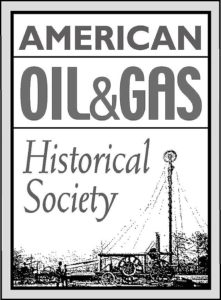March 31, 1919 – Oklahoma’s Other First Oil Well –
The Cherokee-Warren Oil and Gas Company incorporated — taking over the remaining assets of the exploration venture that drilled Oklahoma’s “other first oil well” in Indian Territory. That well, drilled in 1889 but abandoned by the United States Oil and Gas Company, was on a 100,000-acre lease in the Cherokee Nation.
Edward Byrd, a Cherokee by marriage, had found oil seeps southwest of Chelsea in 1882. Two years later the Cherokee Nation authorized his United States Oil and Gas Company, “for the purpose of finding petroleum, or rock oil, and thus increasing the revenue of the Cherokee Nation.”
Learn more in Another First Oklahoma Oil Well.
April 1, 1911 – First Gusher of “Pump Jack Capital of Texas”
South of the Red River border with Oklahoma, near Electra, Texas, the Clayco Oil & Pipe Line Company’s Clayco No. 1 well launched an oil boom that would last decades. “As news of the gusher spread through town, people thought it was an April Fools joke and didn’t take it seriously until they saw for themselves the plume of black oil spewing high into the sky,” noted a local historian.
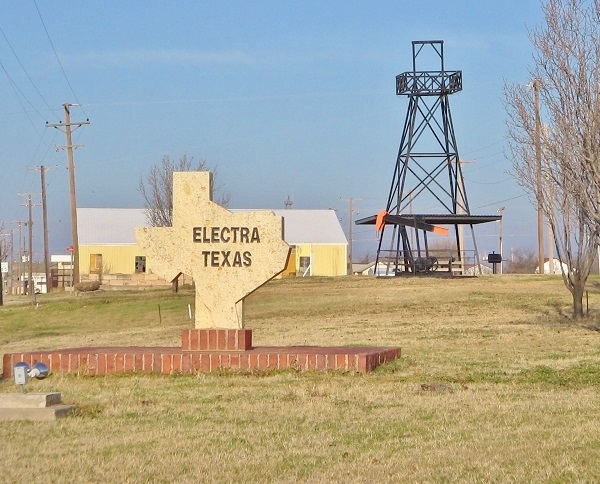
Electra was named after the daughter of rancher W.T. Waggoner, who once complained about oil in water wells drilled for his cattle. Photo by Bruce Wells
The well on cattleman William Waggoner’s lease settled into production of 650 barrels per day from about 1,600 feet deep. Hundreds of producing wells followed, leading to the Electra oilfield’s peak production of more than eight million barrels in 1913. Oil fever would return to North Texas in 1917 when “Roaring Ranger” erupted in neighboring Eastland County.
Learn more in Pump Jack Capital of Texas.
April 1, 1986 – Oil Price Collapse
World oil prices briefly fell below $10 a barrel on the New York Mercantile Exchange. Causes included excessive OPEC production, worldwide recession, and a U.S. petroleum industry regulated by production and price controls. Saudi Arabia had slowed its policy of cutting output to support prices. “The Saudis and other Persian Gulf producers are trying to push oil prices down as part of a long-term strategy to restore their political and economic leverage in the world oil trade,” reported the Washington Post.
April 1, 2011 – Cherokee Strip Regional Heritage Center opens
The $10 million Cherokee Strip Regional Heritage Center (CSRHC) opened in Enid “to fulfill our pledge of claiming our past and inspiring our future,” announced Lew Ward, the center’s chairman and an Enid independent producer. Galleries and exhibits in the northwestern Oklahoma facility document the region’s petroleum history.

The Cherokee Strip Regional Heritage Center in Enid, Oklahoma, includes a 1927 portable drilling rig invented by George E. Failing.
CSRHC offers a rare look at the 1927 portable drilling rig invented by George Failing that uses the truck engine to power a rotary bit for rapid drilling (see Technology and the “Conroe Crater”). The center also preserves the history of Enid-based Champlin Refining Company, once the nation’s largest fully integrated oil company under private ownership.
April 2, 1980 – President Carter signs Crude Oil Windfall Profit Tax
One year after lifting price controls on oil, President Jimmy Carter signed the Crude Oil Windfall Profit Tax (WPT) into law. It would be repealed eight years later. The controversial WPT levied an excise tax on domestic oil production from 1980 to 1988, according to historian Joseph Thorndike.
The WPT, “imposed an excise levy on domestic oil production, taxing the difference between the market price of oil and a predetermined base price.”
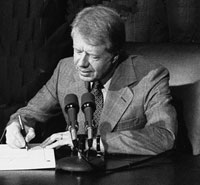
President Jimmy Carter signed the Crude Oil Windfall Profit Tax in 1980. Congress repealed it eight years later.
The base price was derived from 1979 oil prices and required annual adjustments for inflation. A remnant of President Richard Nixon’s wage and price controls of 1971 and the OPEC oil embargo, WPT was meant to limit jumps in oil prices. Eight years of the tax resulted in U.S. oil production falling to its lowest point in two decades. The industry’s depressed state compelled Congress to repeal WPT in 1988.
April 4, 1951 – First North Dakota Oil Well taps Williston Basin
After eight months of drilling in weather that included severe snowstorms, Amerada Petroleum discovered a North Dakota oilfield. The well revealed the Williston Basin two miles beneath Clarence Iverson’s farm near Tioga. Within two months, other exploration companies rushed to the region and leased almost 30 million acres. The petroleum-rich geologic basin proved to extend into Montana, South Dakota, and Canada.
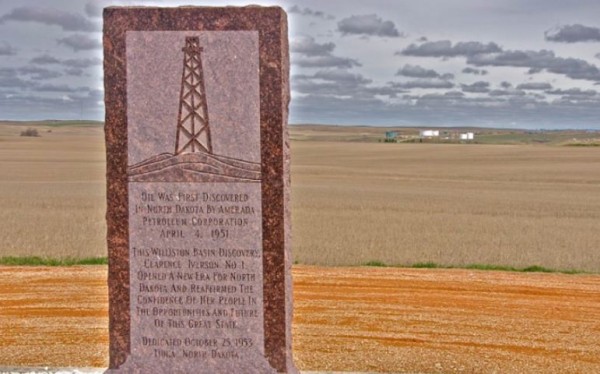
A monument dedicated in 1953 commemorates the Clarence Iverson No. 1 well, which two years earlier discovered the 134,000-square-mile Williston Basin on Iverson’s farm.
The Iverson farm discovery well reached 10,500 feet deep in March 1951 before a blizzard ended operations, according to historian James Key. Drilling resumed until the well was perforated from 11,630 feet to 11,640 feet (using shaped charges at four holes per foot). On the evening of April 4, “a new industry was born in North Dakota,” Key noted. “This was the first major discovery in a new geologic basin since before World War II.”
Learn more in First North Dakota Oil Well.
April 5, 1860 – Oil Industry grows in Pennsylvania
Inspired by Edwin L. Drake’s August 1859 first U.S. oil well at nearby Titusville, Pennsylvania, a newly formed company discovered an oilfield along the Allegheny River at Oil City. With oil fever attracting thousands, five partners organized one of America’s earliest oil ventures, the Phillips, Frew & Company.
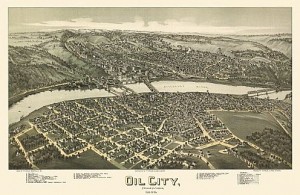
Oil discoveries in the Allegheny River Valley established the earliest U.S. petroleum exploration and production companies. Oil City 1896 “Aero View” map by T.M. Fowler courtesy Library of Congress.
After drilling twice as deep as the Drake well, the company discovered another oil-producing sand formation at a depth of 197 feet. The well produced 42 barrels of oil on its first day, earning the company $882 ($33,757 in 2025 dollars). Within weeks, a shipment of 60 barrels of oil traveled on barges down the Allegheny River to kerosene refineries in Pittsburgh.
April 5, 1976 – Strategic Oil Reserves commercialized
President Gerald Ford signed the Naval Petroleum Reserves Production Act, which for the first time allowed full commercial development of the nation’s three Naval Petroleum Reserves. The legislation resulted from oil shortages created by the 1973-1974 Arab oil embargo.
The Act stipulated oil, natural gas, and liquid products produced from the reserves to be sold at market rates by the Department of Energy. According to DOE, California’s Elk Hills field, which produced its one-billionth barrel of oil in 1992, generated more than $17 billion in profits for the U.S. Treasury. The Elk Hills field was privatized in 1998.
April 5, 1979 – Ending Oil Price Controls
A week after a national referendum in Iran overwhelmingly supported becoming the Islamic Republic of Iran, and with U.S. oil prices averaging $15.85 per barrel, President Jimmy Carter initiated the phased deregulation of price controls established by the Nixon Administration in 1971. Deregulating domestic oil price controls would lead to increased production from Alaska’s Prudhoe Bay oilfields and a decline in Middle East oil imports (also see Trans-Alaska Pipeline History).
_______________________
Recommended Reading: The Oklahoma Petroleum Industry (1980); Early Texas Oil: A Photographic History, 1866-1936
(2000); The Prize: The Epic Quest for Oil, Money & Power (1991); Myth, Legend, Reality: Edwin Laurentine Drake and the Early Oil Industry
(2009); The Bakken Goes Boom: Oil and the Changing Geographies of Western North Dakota
(2016). Your Amazon purchase benefits the American Oil & Gas Historical Society. As an Amazon Associate, AOGHS earns a commission from qualifying purchases.
_______________________
The American Oil & Gas Historical Society (AOGHS) preserves U.S. petroleum history. Please become an AOGHS annual supporter and help maintain this energy education website and expand historical research. Contact bawells@aoghs.org. © 2025 Bruce A. Wells. All rights reserved.



